| |
|
|
|
|
| |
|
|
|
|
| |
|
|
|
|
| |
|
MERIT
Fair 2006
|
|
|
| |
|
Overview, Project Abstracts, Presentation Slides & Posters, & Research Papers |
|
|
| |
|
Friday, August 11, 2006 |
|
|
| |
|
|
|
|
| |
|
|
|
|
| |
|
MERIT 2006 Student Participants
(click on photos to enlarge)
|
|
|
| |
|
The MERIT Fair is held
at the end of the summer to showcase the research conducted by the
undergraduate students during the summer. This forum provides them
with the opportunity to present their work to the wider public.
Their efforts are subjected to scrutiny form a panel of judges selected
from academia, industry, and government laboratories. Winners are
selected in each of the two areas of technical focus: MICRA
and RITE. The prize winning projects are listed just below with
a complete listing of all MERIT 2006 projects after that. |
|
|
| |
|
|
|
|
| |
|
MERIT
Fair 2006 Prize Winning Projects |
|
|
| |
|
|
|
|
| |
|
|
|
|
| |
|
Microelectronics Research (MICRA) |
|
|
| |
|
|
|
|
| |
|
Research Internships in Telecommunications Engineering (RITE) |
|
|
| |
|
|
|
|
| |
|
|
|
|
| |
|
MICRA Projects |
|
|
| |
|
|
|
|
|
|
Electron Beam Induced Deposition of Platinum Contacts
Daniel Chang (Princeton University)
Mentors:
Prof. John Melngailis (UMCP),
Dr. Matthew Ervin (Army Research Laboratory)
John Barry (UMCP),
Dr. Barbara Nichols (Army Research Laboratory), and
Dr. Alma Wickenden (Army Research Laboratory).
 Electron beam induced deposition (EBID) is being investigated as a means of incorporating non-conventional materials such as polymer fibers and carbon nanotubes into integrated circuits. A novel inorganic platinum precursor – Pt(PF3)4 – was tested, as it has been demonstrated to deposit Pt with conductivity close to bulk Pt. Atomic force microscopy, energy dispersive x-ray analysis, scanning electron microscopy, and other techniques were used to characterize EBID-formed Pt deposits as well as to study the mechanism of deposition. Deposit purity was shown to improve after annealing. Platinum contacts capable of integrating carbon nanotubes onto a chip were successfully demonstrated. Electron beam induced deposition (EBID) is being investigated as a means of incorporating non-conventional materials such as polymer fibers and carbon nanotubes into integrated circuits. A novel inorganic platinum precursor – Pt(PF3)4 – was tested, as it has been demonstrated to deposit Pt with conductivity close to bulk Pt. Atomic force microscopy, energy dispersive x-ray analysis, scanning electron microscopy, and other techniques were used to characterize EBID-formed Pt deposits as well as to study the mechanism of deposition. Deposit purity was shown to improve after annealing. Platinum contacts capable of integrating carbon nanotubes onto a chip were successfully demonstrated.
Presentation Slides
Poster Presentation
|
|
|
|
|
Capacitive Characteristics of Carbon Nanotube Field Effect Transistors
Kristen Dorsey (Franklin W. Olin College of Engineering)
Mentors:
Prof. Michael Fuhrer(UMCP),
Dr. Barbara Nichols (Army Research Laboratory),
Dr. Alma Wickenden (Army Research Laboratory),
Dr. Andrew Perrella (Army Research Laboratory, and
Gokhan Esen (UMCP)
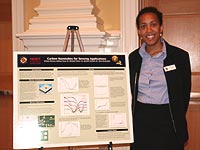 This work focused on using carbon nanotube field effect transistors (CNTFETs) for gas sensing applications. CNTFETs were fabricated with Cr/Au source and drain contacts with an Al top gate contact, using Al2O3 as a gate oxide dielectric which is formed when Al is deposited on the carbon nanotubes(CNTs). By measuring the change in capacitance between the gate and channel for different conditions, the CNTFETs may be used as gas sensors. Different CNT device architectures were explored, tested for capacitive characteristics under varying conditions, and modeled against predicted capacitance behavior. This work focused on using carbon nanotube field effect transistors (CNTFETs) for gas sensing applications. CNTFETs were fabricated with Cr/Au source and drain contacts with an Al top gate contact, using Al2O3 as a gate oxide dielectric which is formed when Al is deposited on the carbon nanotubes(CNTs). By measuring the change in capacitance between the gate and channel for different conditions, the CNTFETs may be used as gas sensors. Different CNT device architectures were explored, tested for capacitive characteristics under varying conditions, and modeled against predicted capacitance behavior.
Presentation Slides
Poster Presentation
|
|
|
|
|
Integration & Characterization of Functional Nano-Technology Materials on a Single Chip
Ratanak Heng (University of Maryland at College Park)
Mentors:
Prof. R. D. Vispute(UMCP), and
Dr. Stephen Kilpatrick (Army Research Laboratory)
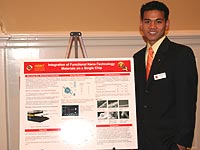 New materials demonstrating feasibility for the integration of nano-dimensional devices with multifunctional characteristics on a single chip are being developed. This project focuses in particular on the growth and characterization of ZnO nanowires/nanorods from the edge of a thin film/heterostructure fabricated on suitable substrate by PLD. The main objective is to identify the best thin film material and its thickness for nucleating ZnO nanowires, and develop growth mechanisms that could yield controlled nanostructure type/shape/size on nanoscaled nucleation layers. The project also involves etching of sidewalls using lithography, growth of nanowires, and characterization of nanostructures using SEM. New materials demonstrating feasibility for the integration of nano-dimensional devices with multifunctional characteristics on a single chip are being developed. This project focuses in particular on the growth and characterization of ZnO nanowires/nanorods from the edge of a thin film/heterostructure fabricated on suitable substrate by PLD. The main objective is to identify the best thin film material and its thickness for nucleating ZnO nanowires, and develop growth mechanisms that could yield controlled nanostructure type/shape/size on nanoscaled nucleation layers. The project also involves etching of sidewalls using lithography, growth of nanowires, and characterization of nanostructures using SEM.
Presentation Slides
Poster Presentation
|
|
|
|
|
Modeling and Measurement of Semiconducting Nanotube Transistors
Tal Rusak (Cornell University)
Mentors:
Prof. Neil Goldsman(UMCP),
Dr. Akin Akturk(UMCP), and
Dr. Alma Wickenden (Army Research Laboratory)
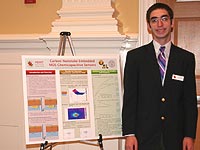 Carbon nanotubes (CNTs) are rolled sheets of carbon whose atoms are arranged in a hexagonal pattern. CNTs measure about a millionth of a millimeter in diameter, and show great promise for nanotechnology applications. Use of CNTs in nanoelectronics can lead to nanoscale sensitive devices, such as sensors that can detect environmentally toxic microscopic agents. To investigate the electrical properties of such sensors, CNT-embedded metal-oxide-semiconductor structures are analyzed using numerical modeling. The Poisson equation is solved to obtain the electrostatic potential and capacitance of sensor devices. The effects of CNTs on device performance are examined by graphing results in three dimensions. Carbon nanotubes (CNTs) are rolled sheets of carbon whose atoms are arranged in a hexagonal pattern. CNTs measure about a millionth of a millimeter in diameter, and show great promise for nanotechnology applications. Use of CNTs in nanoelectronics can lead to nanoscale sensitive devices, such as sensors that can detect environmentally toxic microscopic agents. To investigate the electrical properties of such sensors, CNT-embedded metal-oxide-semiconductor structures are analyzed using numerical modeling. The Poisson equation is solved to obtain the electrostatic potential and capacitance of sensor devices. The effects of CNTs on device performance are examined by graphing results in three dimensions.
Presentation Slides
Poster Presentation
|
|
|
| |
|
|
|
|
| |
|
RITE Projects |
|
|
| |
|
|
|
|
|
|
BioLabs-On-A-Chip: Monitoring Cells Using CMOS Biosensors
Eric Chen (University of Maryland at College Park)
Harneet Khurana (University of Maryland at College Park)
Mentors:
Prof. Pamela Abshire (UMCP),
Nicole Nelson (UMCP),
Somashekar Bangalore (UMCP),
Alfred Haas (UMCP), and
Marc Dandin (UMCP),
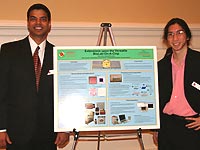 The cell clinics project at University of Maryland aims to realize a BioLab-On-A-Chip that investigates biological cells in order to augment current capabilities and to replace the significant laboratory infrastructure required to presently perform these cell biology tasks. This MERIT project aims to verify the methodology through short-term and long-term monitoring of PC12 cells differentiated with NGF and of bovine aortic smooth muscle cells stimulated with sodium nitroprusside dihydrate. Data acquisition software has been refined using modules provided by National Instruments. In addition, improved packaging methods are being developed by transitioning from Loctite to SU8 biocompatible encapsulation. Meanwhile, extended applications of the technology are being explored; new sensors for high-density monitoring of neurite outgrowth have been designed, simulated, and submitted for fabrication. The cell clinics project at University of Maryland aims to realize a BioLab-On-A-Chip that investigates biological cells in order to augment current capabilities and to replace the significant laboratory infrastructure required to presently perform these cell biology tasks. This MERIT project aims to verify the methodology through short-term and long-term monitoring of PC12 cells differentiated with NGF and of bovine aortic smooth muscle cells stimulated with sodium nitroprusside dihydrate. Data acquisition software has been refined using modules provided by National Instruments. In addition, improved packaging methods are being developed by transitioning from Loctite to SU8 biocompatible encapsulation. Meanwhile, extended applications of the technology are being explored; new sensors for high-density monitoring of neurite outgrowth have been designed, simulated, and submitted for fabrication.
Presentation Slides
Poster Presentation
Research Paper
|
|
|
|
|
An Integrated Algorithm for Motion Deblurring
Ian Tagge (University of Portland)
Mentors:
Prof. Rama Chellappa(UMCP) and
Amit Aagrawal (UMCP)
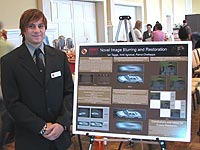 Moving objects or camera motion can cause motion blur in conventional single-exposure photography. Raskar, Agrawal and Tumblin at MERL, have developed an algorithm that compensates for blurring effects due to relative motion on an image. This project extends their work by building a user interface whose input is the blurred image. Interactively, the user can specify constraints on the deblurring function. The results are displayed as constraints are adjusted. Users will be able to specify constraints to reblur the image and create novel effects not producible by normal object motion or camera motion. Moving objects or camera motion can cause motion blur in conventional single-exposure photography. Raskar, Agrawal and Tumblin at MERL, have developed an algorithm that compensates for blurring effects due to relative motion on an image. This project extends their work by building a user interface whose input is the blurred image. Interactively, the user can specify constraints on the deblurring function. The results are displayed as constraints are adjusted. Users will be able to specify constraints to reblur the image and create novel effects not producible by normal object motion or camera motion.
Presentation Slides
Research Paper
|
|
|
|
|
Detection of Humans Carrying Concealed Objects
Jeremy Copeland Webb (The Citadel)
Mentors:
Prof. Rama Chellappa (UMCP) and
Yang Ran (UMCP)
 Computer vision methods for detecting humans carrying concealed objects on an ankle or around the midsection were studied. Data was collected, tested and a computer vision system was developed to “see” changes in human gait as a result of concealed objects. It was determined that concealed objects that affect the geometric symmetry in human gait can be recognized by this computer vision system. This work has applications in video surveillance. In particular, the use of computers to recognize individuals carrying concealed objects. Computer vision methods for detecting humans carrying concealed objects on an ankle or around the midsection were studied. Data was collected, tested and a computer vision system was developed to “see” changes in human gait as a result of concealed objects. It was determined that concealed objects that affect the geometric symmetry in human gait can be recognized by this computer vision system. This work has applications in video surveillance. In particular, the use of computers to recognize individuals carrying concealed objects.
Presentation Slides
Poster Presentation
Research Paper
|
|
|
|
|
Effects of Atmospheric Turbulence on Laser Propagation
Michael Mendoza (Brigham Young University)
William Jones (University of Maryland at College Park)
Mentors:
Prof. Chris Davis (UMCP) and
Joe Harris (UMCP)
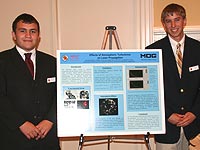 New technologies in direct line of sight wireless communication systems are being developed at the University of Maryland. These are hybrid systems that use both free-space optical (FSO) communication links and radio frequency links (RF). The focus of this summer’s project is to characterize the affects of atmospheric turbulence on laser beam (FSO) communication links. To acquire and analyze atmospheric data a Helium-Neon laser is directed at a distant Schmidt-Cassegrain telescope. The optical data is then gathered from the telescope by a high performance CCD camera connected to a laptop. LabVIEW software is used to capture the desired data and analyze it using the appropriate statistics including the calculation of intensity correlation functions. New technologies in direct line of sight wireless communication systems are being developed at the University of Maryland. These are hybrid systems that use both free-space optical (FSO) communication links and radio frequency links (RF). The focus of this summer’s project is to characterize the affects of atmospheric turbulence on laser beam (FSO) communication links. To acquire and analyze atmospheric data a Helium-Neon laser is directed at a distant Schmidt-Cassegrain telescope. The optical data is then gathered from the telescope by a high performance CCD camera connected to a laptop. LabVIEW software is used to capture the desired data and analyze it using the appropriate statistics including the calculation of intensity correlation functions.
Presentation Slides
Poster Presentation
Research Paper
|
|
|
|
|
Speaker Recognition and Voice Mining
Olakunle Ogunsuyi (University of the District of Columbia, Washington, D.C.)
Mentors:
Prof. Carol Espy-Wilson (UMCP),
Sandeep Manocha (UMCP), and
Srikanth Vishnubhotla (UMCP)
 This research addresses issues in voice mining the real ENRON speech database which consists of low-quality multi-speaker conversations. First, the problem of segmenting the multi-speaker conversations was considered and results show that no segmentation works better than traditional segmentation techniques. However, a semi-automatic approach allowing for manual segmentation to build pure speaker models can yield a significant improvement. Second, the issue of how much manually-segmented data are needed for the speaker model was considered. Comparable results were obtained for no segmentation versus two minutes of manually segmented data. However, when the data were increased to four minutes, performance improved by 9%. This research addresses issues in voice mining the real ENRON speech database which consists of low-quality multi-speaker conversations. First, the problem of segmenting the multi-speaker conversations was considered and results show that no segmentation works better than traditional segmentation techniques. However, a semi-automatic approach allowing for manual segmentation to build pure speaker models can yield a significant improvement. Second, the issue of how much manually-segmented data are needed for the speaker model was considered. Comparable results were obtained for no segmentation versus two minutes of manually segmented data. However, when the data were increased to four minutes, performance improved by 9%.
Presentation Slides
Poster Presentation
Research Paper
|
|
|
|
|
Recognition of Nasalized and Non-nasalized vowels using MFCCs and HMMs
Bilal A. Raja (University of Maryland at College Park)
Mentors:
Prof. Carol Espy-Wilson (UMCP) and
Tarun Pruthi (UMCP)
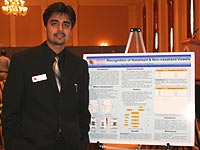 When vowels are adjacent to nasal consonants (/m,n,ng/), they often become nasalized for at least some part of their duration. This nasalization is known to lead to changes in perceived vowel quality. The goal of this project is to verify if it is beneficial to first recognize nasalization in vowels and treat the three groups of vowels (those occurring before nasal consonants, those occurring after nasal consonants, and the oral vowels which are vowels that are not adjacent to nasal consonants) separately rather than collectively for recognizing vowel identities. The standard Mel-Frequency Cepstral Coefficients (MFCCs) and the Hidden Markov Model (HMM) paradigm have been used for this purpose. The results show that when the system is trained on vowels in general, the recognition of nasalized vowels is 17% below that of oral vowels. This result suggests that automatic recognition of vowels would be greatly improved if we could first detect nasalization. When vowels are adjacent to nasal consonants (/m,n,ng/), they often become nasalized for at least some part of their duration. This nasalization is known to lead to changes in perceived vowel quality. The goal of this project is to verify if it is beneficial to first recognize nasalization in vowels and treat the three groups of vowels (those occurring before nasal consonants, those occurring after nasal consonants, and the oral vowels which are vowels that are not adjacent to nasal consonants) separately rather than collectively for recognizing vowel identities. The standard Mel-Frequency Cepstral Coefficients (MFCCs) and the Hidden Markov Model (HMM) paradigm have been used for this purpose. The results show that when the system is trained on vowels in general, the recognition of nasalized vowels is 17% below that of oral vowels. This result suggests that automatic recognition of vowels would be greatly improved if we could first detect nasalization.
Presentation Slides
Poster Presentation
Research Paper
|
|
|
|
|
Nonlinear Mach-Zehnder Interferometer as a DPSK Signal Regenerator
Chad Ropp (University of Maryland at College Park)
Faculty Mentor: Prof. Julius Goldhar (UMCP)
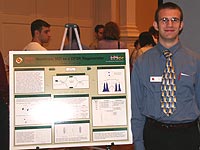 Nonlinear Mach-Zehnder interferometers (MZI), when driven by a phase-locked local oscillator pump, provide phase sensitive amplification to input signals. Phase noise clean up is achieved as a result. Designing the device to operate in saturation with distortion provides added amplitude noise reduction. Using this approach, a scheme for differential phase-shift keyed (DPSK) regeneration is proposed. A steady state model is developed using different nonlinear media including Kerr media, saturable gain, saturable absorption, and two-photon absorption. Comparative analysis of these devices is given with an emphasis on both phase and amplitude regeneration and signal quality as seen by the receiver. Nonlinear Mach-Zehnder interferometers (MZI), when driven by a phase-locked local oscillator pump, provide phase sensitive amplification to input signals. Phase noise clean up is achieved as a result. Designing the device to operate in saturation with distortion provides added amplitude noise reduction. Using this approach, a scheme for differential phase-shift keyed (DPSK) regeneration is proposed. A steady state model is developed using different nonlinear media including Kerr media, saturable gain, saturable absorption, and two-photon absorption. Comparative analysis of these devices is given with an emphasis on both phase and amplitude regeneration and signal quality as seen by the receiver.
Presentation Slides
Poster Presentation
Research Paper
|
|
|
|
|
High Powered Wideband Microwave Interference on Switching Power Supplies
Konstantin Khrustov (University of Illinois at Chicago)
Saket Vora (North Carolina State University)
Mentors:
Prof. Victor Granatstein (UMCP),
Prof. John Rodgers (UMCP), and
Todd Firestone (UMCP)
 With rapid advances in the physical downscaling of integrated circuits, the effects of electromagnetic interference have become too important to ignore. This project explores the effects of high-power wideband microwave interference on feedback circuits in switching power supplies. Spurious fluctuations in these feedback signals may cause electronic systems to reset, shut down, or even sustain physical damage. Identifying the characteristics of disruptive signals is critical to developing countermeasures to them. A traveling-wave tube (TWT) was configured as an oscillator which generated wideband microwave signals with variable amplitude, frequency and pulse width. The power supply functions were measured as its control circuitry was excited by microwave pulses from the TWT. By varying the drive parameters, the regimes where the system is susceptible to microwaves could thus be experimentally determined. The results show that nonlinearity and parasitic resonances in electronic circuits renders them vulnerable to microwave sources even though, by design, these circuits should not respond to such high frequency excitation. With rapid advances in the physical downscaling of integrated circuits, the effects of electromagnetic interference have become too important to ignore. This project explores the effects of high-power wideband microwave interference on feedback circuits in switching power supplies. Spurious fluctuations in these feedback signals may cause electronic systems to reset, shut down, or even sustain physical damage. Identifying the characteristics of disruptive signals is critical to developing countermeasures to them. A traveling-wave tube (TWT) was configured as an oscillator which generated wideband microwave signals with variable amplitude, frequency and pulse width. The power supply functions were measured as its control circuitry was excited by microwave pulses from the TWT. By varying the drive parameters, the regimes where the system is susceptible to microwaves could thus be experimentally determined. The results show that nonlinearity and parasitic resonances in electronic circuits renders them vulnerable to microwave sources even though, by design, these circuits should not respond to such high frequency excitation.
Presentation Slides
Poster Presentation
Research Paper
|
|
|
|
|
A Flexible Address-Event Router for Neuromorphic Systems
Matthew Carlberg (Columbia University)
Marc Goldman (University of Maryland at College Park)
Faculty Mentor:
Prof. Timothy K. Horiuchi (UMCP)
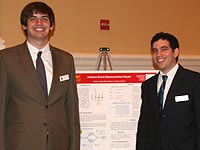 A flexible address-event representation (AER) router system was designed, constructed, and tested for use in various research projects in the Computational Sensorimotor Systems Laboratory. AER is an asynchronous communication protocol for transferring spikes in networked neuromorphic VLSI chips. By representing spikes as addresses, AER can electrically mimic the high parallel connectivity of neurons in a biological system. A CIP-51 microcontroller with two AER input ports and two AER output ports implements mapping, projecting, splitting and merging of spikes. By communicating with MATLAB™ through USB 2.0, the system also allows for on-the-fly changes in functionality and real-time monitoring of input and output spikes. A flexible address-event representation (AER) router system was designed, constructed, and tested for use in various research projects in the Computational Sensorimotor Systems Laboratory. AER is an asynchronous communication protocol for transferring spikes in networked neuromorphic VLSI chips. By representing spikes as addresses, AER can electrically mimic the high parallel connectivity of neurons in a biological system. A CIP-51 microcontroller with two AER input ports and two AER output ports implements mapping, projecting, splitting and merging of spikes. By communicating with MATLAB™ through USB 2.0, the system also allows for on-the-fly changes in functionality and real-time monitoring of input and output spikes.
Presentation Slides
Poster Presentation
Research Paper
|
|
|
|
|
Robot Interaction Using Cricket, an Indoor Positioning System
Hosam Haggag (University of Maryland at College Park)
Golbarg Mehraei (Virginia Commonwealth University)
Mentors:
Prof. P. S. Krishnaprasad (UMCP),
Kevin Galloway (UMCP),
Zachary Kulius (UMCP), and
Joshua Lioi (UMCP),
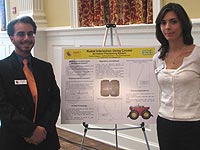 In this project, a revised configuration of the Cricket indoor positioning system is used to enable coordinated robot interaction. The position of a Cricket client is determined by sending RF and ultrasonic signals to beacons on the ceiling of the lab and measuring the time taken for ultrasonic signals to be received. Robots determine their coordinates using this system and share this information to perform a designated task. To improve position estimates when noise is present in Cricket measurements, a Kalman filter is used. In this project, a revised configuration of the Cricket indoor positioning system is used to enable coordinated robot interaction. The position of a Cricket client is determined by sending RF and ultrasonic signals to beacons on the ceiling of the lab and measuring the time taken for ultrasonic signals to be received. Robots determine their coordinates using this system and share this information to perform a designated task. To improve position estimates when noise is present in Cricket measurements, a Kalman filter is used.
Presentation Slides
Poster Presentation
Research Paper
|
|
|
|
|
Practical Implementation and Evaluation of Intelligent Cooperative Ad-Hoc Networks
Waseem A. Malik (University of Maryland at College Park)
Alexander Weissman (University of Maryland at College Park)
Mentors:
Prof. K.J. Ray Liu(UMCP),
Dr. Andres Kwasinski(Lab Manager, Communications and Signal Processing Laboratory),
Dr. Wei Yu(Communications and Signal Processing Laboratory), and
Ahmed Sadek(Communications and Signal Processing Laboratory)
 Cooperative- and direct-transmission wireless communication schemes each have their own advantages and disadvantages, dependent on the topography and power limitations of the network. A system that intelligently switches between either mode can fully utilize the advantages of each scheme. By fixing the transmission power level of each node in the network and measuring the data loss for each scheme independently, it can be observed that an intelligent switching system maximizes transmission efficiency. Temporal and spatial locality effects in wireless channels are predicted and tested. Finally, channel stability and optimal relay positioning are analyzed through experimental results. Cooperative- and direct-transmission wireless communication schemes each have their own advantages and disadvantages, dependent on the topography and power limitations of the network. A system that intelligently switches between either mode can fully utilize the advantages of each scheme. By fixing the transmission power level of each node in the network and measuring the data loss for each scheme independently, it can be observed that an intelligent switching system maximizes transmission efficiency. Temporal and spatial locality effects in wireless channels are predicted and tested. Finally, channel stability and optimal relay positioning are analyzed through experimental results.
Presentation Slides
Poster Presentation
Research Paper
|
|
|
|
|
Polarization Dependence in Nonlinear Fiber Optics: Modeling and Experiment
Afrouz Akhavan Azari (University of Maryland at College Park)
Ross Adam Pleban (North Carolina State University)
Mentors:
Prof. Thomas E. Murphy (UMCP) and Reza Salem (UMCP)
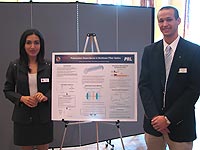 Most currently-used methods for modeling nonlinear propagation in fiber optic do not account for the evolution of the polarization state. A software model has been developed that accounts for the variations in polarization via a numerical approximation and predicts the behavior of a system with different input polarization states. The model uses two methods, an approximation and an exact equation, which have been derived from the nonlinear Schrodinger equation. The approximation closely agrees with experimental data in which the polarization state frequently changes compared to the length of the fiber. The exact method is free of this constraint but takes longer to simulate. The software tool developed for this project will help to better understand experimental observations of polarization dependence, and will help in designing nonlinear optical switches that are insensitive to polarization. Most currently-used methods for modeling nonlinear propagation in fiber optic do not account for the evolution of the polarization state. A software model has been developed that accounts for the variations in polarization via a numerical approximation and predicts the behavior of a system with different input polarization states. The model uses two methods, an approximation and an exact equation, which have been derived from the nonlinear Schrodinger equation. The approximation closely agrees with experimental data in which the polarization state frequently changes compared to the length of the fiber. The exact method is free of this constraint but takes longer to simulate. The software tool developed for this project will help to better understand experimental observations of polarization dependence, and will help in designing nonlinear optical switches that are insensitive to polarization.
Presentation Slides
Poster Presentation
Research Paper
|
|
|
| |
|
|
|
|

















